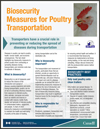Transporters have a crucial role in preventing or reducing the spread of diseases during transportation. Diseases in poultry can lead to poultry health, human health, and economic consequences. This fact sheet highlights key biosecurity measures to protect poultry from contracting or spreading diseases during transportation and minimize costs due to outbreak of diseases.
What is biosecurity?
Biosecurity is a set of measures used to reduce the chance of the introduction and spread of disease-causing organisms and pests. During transportation, poultry can be at risk of contracting infectious disease from exposure to infected poultry, other animals, carcasses and pests (such as rodents and insects) or contact with manure, bodily fluids, dander and aerosols of infected poultry or contaminated trailers, equipment, and people. A chain of strict biosecurity measures is recommended to maintain the health and well-being of poultry at the place of loading, during transportation and at the destination site.
Why is biosecurity important?
The transportation and movement of poultry, particularly those that are infected, provide an opportunity to spread infection/diseases such as Salmonella spp. and avian influenza. The impact and cost of a disease outbreak can far exceed the cost of implementing biosecurity measures to minimize the risk of introduction and spread of infectious diseases. The lack of biosecurity measures during transportation may result in significant financial losses for the transporters and poultry industry.
Who is responsible for biosecurity?
Producers, caretakers, transporters and everyone else involved in the transportation of poultry are responsible for ensuring animal health and welfare. It is recommended that biosecurity measures be implemented at all times during loading, on the road and during unloading. Always discuss biosecurity with the producers/bird owners before transportation.
General Biosecurity Recommendations
- Plan your transportation event.
- Determine and follow biosecurity protocols for departure and destination sites. Respect and follow posted biosecurity signs. For sites where multi-age production occurs, biosecurity to protect the remaining flocks is of utmost importance.
- When accessing sites, avoid muddy or manure-contaminated pathways. Drive slowly to minimize contamination of the undercarriage of the trailer.
- Do not cross-contaminate between the transport unit and the sites.
- Whenever possible, select routes that avoid locations where a disease is identified. Follow disease outbreak updates provided by the CFIA, USDA, and provincial/territorial, or state governments.
- It is recommended that transporters be aware of signs of disease and fitness for transport.
Biosecurity Best Practices
Only load poultry onto clean trailers
Dirty trailers can spread disease. To reduce the risk of spreading disease:
- Clean and disinfect trailers between transportation events.
- Dispose of organic matter (manure, poultry waste, etc.) at designated locations.
- Use effective and compatible cleaning (detergents, degreasers) and disinfection products; consult specialists as needed. Follow manufacturer's recommended water temperature, concentration and contact time. Ensure that trailer surfaces are visually clean and free of all organic matter before applying the disinfectant.
- Before loading, inspect the trailer to ensure that it is dry and clean.
Avoid contact with other animals
Poultry can appear healthy yet still shed pathogens (e.g. bacteria, viruses, and fungi) that can put other poultry at risk of an infection. To reduce this risk:
- Transport healthy birds. It is in the interest of the producers/flock owners that their birds are appropriately vaccinated at the origin site to prevent transmission of common diseases.
- Avoid parking close to the barn exhaust fans, if possible. Avoid contact with barns and flocks that will remain in production on site.
- Whenever possible, choose a route through areas of lowest poultry density.
- Whenever possible at stops, park away from other poultry and livestock trailers.
- It is recommended that identified sick flocks or flocks from farms with identified illness be transported last, followed by complete cleaning and disinfection.
People and equipment
People, crates, modules, dollies, and other equipment that have come into contact with diseased poultry or their environment can pose a risk to poultry. To minimize this risk:
- Clean and disinfect crates, modules, and dollies before loading them on a clean and disinfected trailer. It is recommended that equipment used be free of all organic matter before applying disinfectant.
- Do not share equipment between flocks, farms, or with other drivers.
- It is recommended that the catching crew, transporter, and other personnel that come into contact with the poultry being transported wear protective clean clothing and footwear.
- Always clean and sanitize hands before and after contact with poultry, other animals or equipment.
- Discourage people not involved with the transport from coming into contact with the poultry in the shipment, equipment, and trailer.
- Keep the truck cab clean to prevent cross-contamination between transportation events. Disinfect, if necessary. For example, remove dirty coveralls and footwear before entering the cab.
For more information, visit the biosecurity standard for livestock, poultry and deadstock transportation on the Canadian Food Inspection Agency website at Inspection.gc.ca and Canadian Animal Health Coalition website at Animalhealth.ca.
